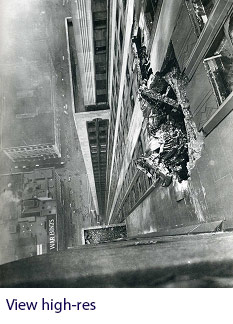Long-time habitues of this space know that there’s no simple pleasure of which we’re more fond than the shoeshine. Few services yield as much satisfaction per dollar spent.
There are a handful of shoeshine parlors near our place of employ, but all but one, Louis Shoe Rebuilders, are dead to us now. This delightful shop, situated on the ground floor of the Empire State Building on the 33rd Street side (honestly, couldn’t we just stop right there? What more could anyone ask of a shine emporium than that it be located in the Empire State Building? But there’s much more to recommend LSR), has been in business since a decade before that storied favorite skyscraper was erected.
Heck, Louis Shoe Rebuilders predates talking pictures by six years. It opened in 1921, relocated while the ESB was erected, and then returned to 33rd Street when the construction was complete.
And yet, as with most neighborhood shine parlors, the prices remain improbably—almost impossibly—low. Had my grandfather ever made his way from Okemah, Oklahoma, to the Murray Hill section of Manhattan back in the 1920s, he would have been charged a quarter for a shoeshine. Today, the tariff is $3, which, allowing for inflation, is virtually the same price.
Consider, by contrast, the cost of a haircut and a shave. In the old days, a tonsorial two-fer ran you the same quarter one paid for a shine (remember that old jingle, “Shave and a haircut—two bits”?). Today, at the barber shop we patronize every two weeks, a shave and a haircut costs $32, tip not included—and that’s a bargain price in our neighborhood. What was the 1921 equivalent of thirty-two smackeroos? Just under three dollars. So while the price of a shave and a haircut, even allowing for inflation, has increased tenfold, while price of a shine has remained, in relative terms, level.
It’s downright miraculous.
What’s more, we very rarely find a shoe shine man (or woman) who isn’t friendly and engaging (and our experience at Louis lived up to that trend), which only heightens the pleasure taken from the experience.
As does the chance to be a relative sport, when it comes to the gratuity. Who wouldn’t pay six dollars, and happily so, for a quality shoe shine at a venerable shop the likes of Louis Shoe Rebuilders? No one but a mean-spirited cheapskate, that’s who, and that six dollars covers the price of the shine, plus a 100% percent tip.
When was the last time you tipped a bartender or a waiter 100%? Perhaps you never have. Well, you can enjoy that rarefied experience at your friendly neighborhood shoeshine stand.
The shine service at Louis is handled these days by Maria and Bolivar Gomez, a married couple in their forties who emigrated to the United States from Ecuador.
When we immediately snapped a couple of photos upon entering the shop, Bolivar shot us a glance that we weren’t quite certain wasn’t askance, so we paused and asked permission, fearing we’d made a misstep. He shrugged his shoulders, as if to say, “Take a picture if you like,” but he seemed none too happy about it. And when we stepped up and took a seat at one of the shine stations, he asked, “How many pictures did you take?”
“Just two,” we said.
“Ten dollars, please,” he said, totally deadpan.
However, Maria’s giggle gave him away immediately, and he quickly apologized for the prank.
As the pictures in the above slidshow confirm, entering Louis Shoe Rebuilders isn’t like stepping into a time machine. The shop’s got a classic look to it, but not an especially vintage one—except for one feature: Along the wall on the left as you enter is a line of small booths that each looks something like a witness stand in a courtroom.
These booths serve the purpose of affording customers—especially female patrons—and their stocking feet some privacy as they await the return of their shoes after as-you-wait repairs are performed.
Needless to say, we immediately fell in love with that row of small booths, and with this shop. And so will you, if you’ll make it a point to stop by the next time you’re in New York.
![]()

